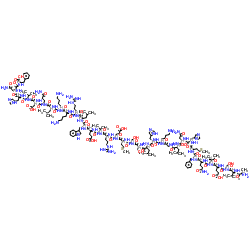Functional evidence for an intramolecular side chain interaction between residues 6 and 10 of receptor-bound parathyroid hormone analogues.
Naoto Shimizu, Brian D Petroni, Ashok Khatri, Thomas J Gardella
Index: Biochemistry 42(8) , 2282-90, (2003)
Full Text: HTML
Abstract
The N-terminal domain of PTH(1-34) is critical for PTH-1 receptor (P1R) activation and has been postulated to be alpha-helical when bound to the receptor. We investigated the possibility that the side chains of residues 6 (Gln) and 10 (Gln or Asn) of PTH analogues, which would align on the same face of the predicted alpha-helix, could interact and thereby contribute to the PTH/P1R interaction process. We utilized PTH(1-11), PTH(1-14), and PTH(1-34) analogues substituted with alanine at one or both of these positions and functionally evaluated the peptides in cell lines (HKRK-B7 and HKRK-B28) stably expressing the P1R, as well as in COS-7 cells transiently expressing either the P1R or a P1R construct that lacks the amino-terminal extracellular domain (P1R-DelNt). In HKRK-B7 cells, the single substitutions of Gln(6) --> Ala and Gln(10) --> Ala reduced the cAMP-stimulating potency of [Ala(3),Gln(10),Arg(11)]rPTH(1-11)NH(2) approximately 60- and approximately 2-fold, respectively, whereas the combined Ala(6,10) substitution resulted in a approximately 2-fold gain in potency, relative to the single Ala(6) substitution. Similar effects on P1R-mediated cAMP-signaling potency and P1R-binding affinity were observed for these substitutions in [Aib(1,3),Gln(10),Har(11),Ala(12),Trp(14)]rPTH(1-14)NH(2). Installation of a lactam bridge between the Lys(6) and the Glu(10) side chains of [Ala(3,12),Lys(6),Glu(10),Har(11),Trp(14)]rPTH(1-14)NH(2) increased signaling potency 6-fold, relative to the nonbridged linear analogue. Alanine substitutions at positions 6 and/or 10 of [Tyr(34)]hPTH(1-34)NH(2) did not affect signaling potency nor binding affinity on the intact P1R; however, Ala(6) abolished PTH(1-34) signaling on P1R-DelNt, and this effect was reversed by Ala(10). The overall data support the hypothesis that the N-terminal portion of PTH is alpha-helical when bound to the activation domain of the PTH-1 receptor and they further suggest that intrahelical side chain interactions between residues 6 and 10 of the ligand can contribute to the receptor interaction process.
Related Compounds
| Structure | Name/CAS No. | Molecular Formula | Articles |
|---|---|---|---|
 |
pTH (1-34) (bovine)
CAS:12583-68-5 |
C183H288N54O50S2 |
|
Thyroid hormones enhance the biomechanical functionality of ...
2015-01-01 [Arthritis. Res. Ther. 17 , 28, (2015)] |
|
Identification of a novel parathyroid hormone-responsive gen...
1999-04-01 [Bone 24(4) , 305-13, (1999)] |
|
Functional properties of a synthetic chicken parathyroid hor...
1994-07-01 [J. Bone Miner Res. 9(7) , 1041-6, (1994)] |
|
Comparison of the effects of various lengths of synthetic hu...
1993-01-01 [Bone 14(5) , 717-20, (1993)] |
|
Anomalous effects of hormone fragments on the measurement of...
1996-03-01 [Methods Find. Exp. Clin. Pharmacol. 18(2) , 87-99, (1996)] |